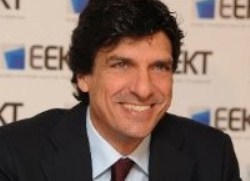Broadband Forum forges ahead with holistic approach to broadband network development

George Stefanopoulos
A new conception of broadband is on target to be achieved as the industry experiences an era of unparalleled change and challenge, and networks transform to meet the opportunities of 5G,‘cloudification,’ the Internet of Things (IoT), gigabit access, open source solutions and the growing influence of Artificial Intelligence (AI).
That was the message delivered at the Broadband Forum’s sell-out BASE Athens event which brought together operators, service providers, system integrators, vendors, academia and industry bodies to discuss the entire broadband ecosystem and the technology developments needed to deliver future broadband networks.
“Like all the countries across Europe, my members are facing multiple challenges and opportunities as we look forward to 5G and IoT possibilities, allied to how they will interwork with new technologies such as Network Functions Virtualisation (NFV) and even AI,” said George Stefanopoulos, general manager of Greek Mobile Operators Association (EEKT). “Whatever the technologies, the choice is always going to be finding the right balance between investment capability, generating demand for services and supporting this with a friendly regulatory and licensing environment.”
“BASE gave Greece the chance to host this truly international gathering and share our thoughts, ideas and experiences with colleagues from across the entire ecosystem. I was delighted to give our views and listen to what others had to say – I’m sure we have all learnt a lot during the two days of the event,” added Stefanopoulos.
 Stefanopoulos was joined on the stage by a host of operators and vendors, with subjects covered including virtualised broadband, cloud services, the managed home, 5G, wireless/wireline convergence, Wi-Fi performance and high-speed access, including NG-PON2, XGS-PON, MoCA and Gfast.
Stefanopoulos was joined on the stage by a host of operators and vendors, with subjects covered including virtualised broadband, cloud services, the managed home, 5G, wireless/wireline convergence, Wi-Fi performance and high-speed access, including NG-PON2, XGS-PON, MoCA and Gfast.
Details of the latest Broadband Forum projects were also revealed. Tim Carey, of Nokia, gave an update on the Broadband Forum’s Broadband Access Abstraction (BAA) project which aims to drive the adoption of software-defined access networks via open source software development.
“As more operators look to agile, software-based network models, uniting vendors and operators to ensure they are aligned with industry specifications to meet the needs of operators globally is incredibly important for long-term success,” said Carey.
“By defining a software reference implementation for an open BAA layer through standardised interfaces, software can be decoupled from the underlying hardware to isolate the core functionality from specific device implementations and limit the number of different interfaces that are needed to be supported by service providers and vendors.”
BAA is part of the Broadband Forum’s Open Broadband initiative, a collaborative space for the integration and testing of new open source, standards-based and vendor provided implementations.

Tim Carey
This is just one example of the recent innovation being carried out by the Forum, as it continues to deliver on its Broadband 20/20 vision. Last year also saw the publication of its ‘Fixed Access Network Sharing – Architecture and Nodal Requirements’ Technical Report (TR-370), which standardises Fixed Access Network Sharing (FANS).
At the BASE event in Athens Vodafone’s Fixed Access manager, Bruno Cornaglia, set out his vision for this technology.
“To create a unified access architecture, it is essential to integrate all technologies – from FTTC to FTTH and Cable –in a single approach,” said Cornaglia. “In urban areas, NG-PON2 represents the suitable solution for backhauling all other technologies, such as GPON in remote nodes, micro-nodes with VDSL2 and Gfast, DOCSIS remote devices, and mobile, but in rural areas operators face additional difficulties when deploying next-generation access.
Here, introducing FANS on top of the unified access platform can facilitate the development of Next-Generation Access networks by giving full control to different service providers, or different divisions within the same company, enabling them to independently manage their own customers, even if there is only one physical network.”
During the BASE workshop, Cornaglia also highlighted why good network monitoring is important and how the new ΔQmetric can improve network performance and Quality of Service. According to Cornaglia, the ΔQ data can then be used by machine learning to enhance network operation.
The full line-up of operators, service providers and vendors taking part in the event was as follows:
- ADTRAN
- Broadband Trends
- BSNL, India Dept of Telecoms
- Cartesian
- Consulting SARL
- CYTA
- Ericsson
- European Competitive Telecommunications Association
- Greek Mobile Operators Association
- Huawei Technologies
- Intel
- Metanoia
- Nokia
- SK Telecom
- Tibit Communications
- Verizon
- Arris
- Boosty
- BT Mobile
- Calix
- Corning
- Deutsche Telekom
- Eulambia
- Federation of Hellenic Information Technology and Communication Enterprises
- inCITES
- Intracom Telecom
- Mimosa
- Sckipio
- Tessares
- UNH-IOL
- Vodafone
“This latest BASE event brought together a vast array of speakers, covering an unparalleled range of topics, from NG-PON2 and Gfast to virtualidation and converged networks for 5G,” said Bernd Hesse, chairman of BASE and the Broadband Forum’s NG-PON2 Council, and senior director Technology Development at Calix.
“This ongoing discussion and collaboration, looked holistically at the broadband access network and this is absolutely vital if we are to deliver the ubiquitous next-generation access for many consumers who are already seeing broadband as the fourth utility. We couldn’t have achieved such a successful event without our sponsors – Huawei, Intracom Telecom, Go Foton, Lightron, Hisense Broadband and Calix – thank you.”
For more information, click here.
Comment on this article below or via Twitter @IoTGN
